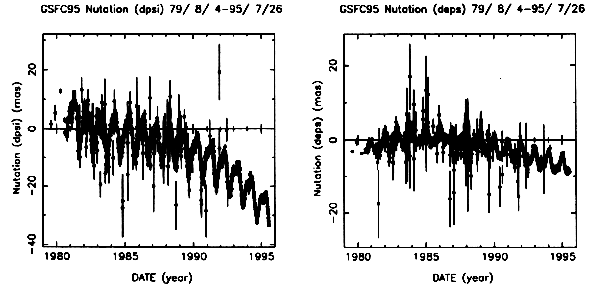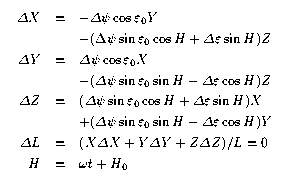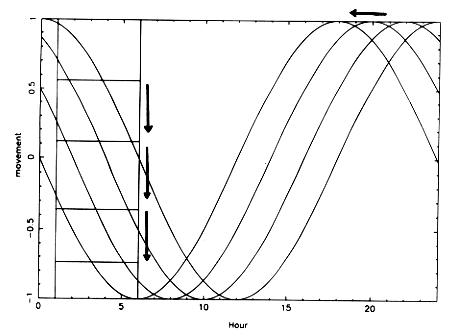
Figure 1. Differences of adjusted nutation parameters Delta psi (dpsi) and Delta epsilon (deps)) from IAU80 model.
Kashima Space Research Center
Communications Research Laboratory
893-1 Hirai, Kashima, Ibaraki 314, Japan
Errors in VLBI measurements are caused by many reasons, such as noise,
atmospheric scintillation, clock fluctuation,
the pseudo delay by the calibration system,
and inaccurate physical model. I investigated the effects of the differences
of the precession and nutation parameters from the model on the station
positions.
The theoretical delay model of the Wahr's nutation model (1980),
and the Lieske's precession model (1976), which were adopted in IAU'80, was used.
The precession error is included in the estimated nutation parameters. Therefore,
I show only the difference of nutation parameters from the Wahr's model in
Figure 1.



There are two types of effects on the station positions (the wobble).
One is an offset and another is a periodical term. Therefore,
the station position changes with a period of 23 hours and 56 minutes.
It is shifted by 4 minutes. When
the observation time is shifted by about 4 minutes every day, the hour
angle H is
the same for every experiment. Therefore, the effects of the modification
for the precession and nutation parameters on the positions are a bias.
When the observation time is fixed, the mean station position during the
experiment has an annual variation.

CRL has conducted the VLBI experiments of KSP (the Crustal Deformation Monitoring System for Tokyo Metropolitan Area) since 1995. These experiments are conducted during 5 hours every day. The time of experiments is nearly fixed. I investigated the effects of the differences of the precession and nutation parameters from the model on the station positions. In the data of KSP experiments, the annual variations and the discontinuity at the change of the observation time were appeared [Takahashi et al., 1996]. These variations may be caused by the differences of the nutation and precession parameters from the IAU80 model. The typical baseline length is about 100 km, and the differences for the ecliptic longitude of -40 mas and for the ecliptic obliquity of -10 mas correspond to about 20 mm in components of the station position. For an east-west baseline such as Kashima-Koganei, the amplitude of periodic variation is about 9 mm for Z component, while the effects on X,Y components are like a bias. The variation of Z components will be corresponding on north and vertical movements.